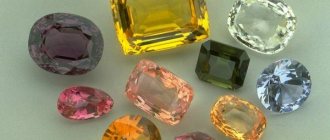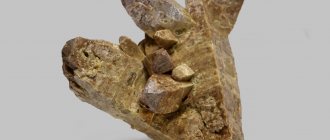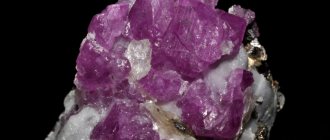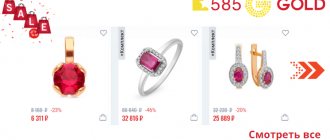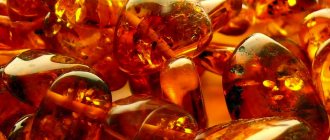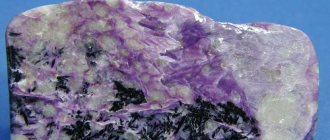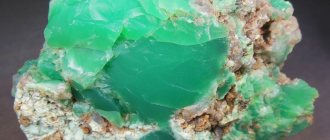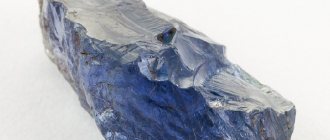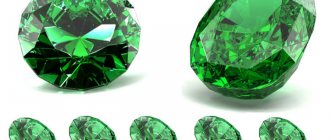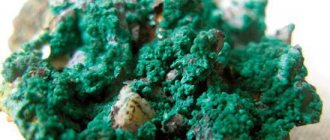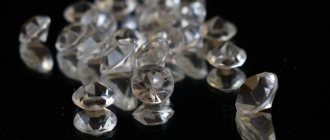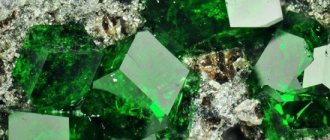| Category | Oxides (minerals) |
| Title in English | Corundum |
| Formula | Al2O3 |
| Group | Corundum group |
| Color | Colorless, Grey, Pink, Red, Blue, Yellow, Green |
| Stroke color | White |
| Shine | Glass, Diamond |
| Transparency | Transparent, Translucent, Opaque |
| singonia | Trigonal |
| Hardness | 9 |
| Cleavage | Imperfect |
| Density, g/cm³ | 3,9 — 4,1 |
| Kink | Rough, Conchoidal |
| origin of name | The name of this mineral comes from the ancient Indian language. Presumably, either the Sanskrit word kuruvinda, which translates as ruby, was used to designate the mineral. Or they could also use the common Indian name for the stone - “kauruntaka”. |
Mineralogists, chemists, mechanical engineers, electronics engineers - they all know the mineral corundum. But among jewelers it did not gain popularity on its own. In jewelry, its valuable varieties are much more important.
Description of corundum
Natural corundum has a transparent structure with a metallic or glassy luster.
Corundum is a mineral with a crystalline structure of alpha aluminum oxide. It is found in nature in the form of pyramids, prisms and barrels. It is considered a gemstone of the highest category. Due to the structure of the crystal lattice, its hardness is second only to diamond and is widely used not only in jewelry, but also in optics, microelectronics and other mechanical industries.
The stone has high transparency, luxurious shine and bright color, but cloudy specimens are more common.
Crystallographic characteristics
syngony L33L23PC.
The class is ditrigonal-scalenohedral.
Crystal structure
Al atoms are located in the octahedral voids of the hexagonal closest packing of O atoms according to the “corundum” motif
- Al atoms fill 2/3 of the octahedral voids). The octahedral layers are superimposed on one another in such a way that there are columns of octahedra elongated along the c axis.
- two filled octahedra alternate with unfilled ones.
It is the only natural modification of alumina. The structure corresponds to artificial α-Al2O3. Among artificial compounds, a number of unstable modifications of Al2O3 have been identified, resulting from heating gibbsite, bayerite and boehmite and representing intermediate products in the transition of trihydrates and boehmite to corundum (α -Al2O3).
Main forms : c (0001), r (1011), n (2243), a (1120) (corresponding to the flat faces of F, according to Hartmann), also z (2241).
Origin story
Corundum has been known since the times of Ancient Egypt and Judea. Mentions of it can be found in ancient texts: it was used to decorate the robes of priests and high priests.
Corundum came to Europe from India, but the name, which has Sanskrit roots, did not take root. Precious stones, which have a common name in the East, were united in the Old World only in the 19th century.
In Russia, the stone has been known since ancient times. Under the name "yakhont" he often appeared in folk art. Researchers are sure that in Rus' this stone was mined independently, although there are hypotheses that it was brought from the East along the Silk Road.
Deposits and stone mining
Corundum forms where igneous rock comes to the surface or in underground air cavities rich in aluminum. It is formed under pressure and high temperatures over thousands of years. Most often, stones can be found in mountain ranges in the form of rare inclusions, so their extraction from the rock is impractical.
There are only a few rich deposits of corundum - terrestrial alluvial rocks. Over millions of years, the mountain range is gradually destroyed, its rock falls into rivers and is polished by water. The hardest particles - rubies, sapphires - are not destroyed and remain in the riverbed at a depth of half a meter. They are removed by washing and digging up the soil in those places where accumulations have formed.
Blue minerals are less common in nature than red ones.
This is how corundum is mined in Thailand, Sri Lanka, Burma and Tanzania. Clusters of blue minerals are more common in rocks and are periodically mined directly from the veins. For example, Kashmir dark blue sapphires are being mined in mines in the Himalayas. Less significant deposits of jewelry stones are located in Madagascar, Myanmar, Russia, Greece, Norway, Australia, Brazil, Canada and the USA.
Types of stone
Types of corundum are distinguished depending on color.
Rubies
Ruby, or red yakhont, is a type of stone with a scarlet color, which is given by impurities of chromium. Transparent rocks are more valuable than diamonds. Burmese rubies are considered the most expensive. They have a rich, deep scarlet hue with a bluish tint - the color of pigeon's blood. Thai stones are distinguished by a light brownish tone - Siamese. Rubies from Sri Lanka are scarlet with a bright crimson tint, and Vietnamese ones are purple.
There is a special type of red yacht with an asterism effect. In another way, this mineral is called star ruby. When light hits the stone, it creates the effect of a star shining inside.
The category of rubies includes primarily stones of a bright red hue.
Sapphires
Sapphire, or azure yakhont, is a precious blue or light blue corundum, colored with titanium atoms. The richest cornflower blue stones from India - Kashmiri - are considered the most valuable. Siamese minerals from Thailand have a greenish tint. Sapphires from Sri Lanka (Ceylon) are light blue with a bluish tint.
In Tanzania, unique stones are mined that change their color depending on the lighting (the so-called alexandrite effect). Shining asterias (star sapphires) and minerals with a cat's eye effect are especially valued by jewelers.
Sapphire is a precious stone that is cheaper than ruby.
Other types
In addition to the familiar rubies and sapphires, there are other types of corundum:
- Padparadscha , which is translated from Sinhala as “lotus color”, is a stone that has an orange-pink color. The iridescence of its shades is poetically called “the color of the sunset tropical sky” or “molten gold.” But this species is valued not only because of its color. Compared to ruby, the mineral is more transparent and has fewer defects. It is believed that real padparadscha is found only in Sri Lanka.
- Green corundums are oriental emeralds, or chlorosapphires, less valuable stones of deep color, sometimes with a yellowish tint.
- Violet - oriental amethysts, iridescent in shades from pink to dark lilac.
- Polychrome sapphires are rare yellow-green, violet-blue or, for example, blue-green corundum. In the structure of the stone, 2 dissimilar colors are visible, which is due to impurities in the rock.
- Leucosapphires , or oriental diamonds, are the rarest varieties. Transparent, with a metallic or glassy sheen, without any color. They are especially highly valued among jewelers because of their uniqueness.
- Emery , or technical muddy corundum, has no jewelry value. Due to its hardness it is used as an abrasive. It can be either white or brown. The first one is looser, but at the same time it is a pure abrasive - it contains 99% Al2O3.
In nature, not only blue and red, but also other varieties of corundum are found.
Price
Precious rubies are the most prized variety of corundum. The price of crystals varies from 50 to 500 dollars per 1 carat. Large nuggets with a bright hue are valued even higher, and those that exceed 5 carats in weight cost up to $1,500.
Sapphires are valued similarly to rubies. The price of crystals is about 40–500 dollars per 1 carat. Natural sapphires that have a reverse effect have a high price. Such gems are valued from 30 to 500 dollars per carat. Yellow, pink or orange sapphires cost from 20-30 to 300-400 dollars per unit.
Colorless corundums are priced between $5 and $150. Black sapphires are quite popular and are valued for their unusual shine and shimmer of the mineral. The cost of such specimens is 5–50 dollars per carat. There is a considerable amount of corundum in black-blue or green shades, which are often passed off as black sapphires. The price for such minerals does not exceed $5 per carat.
Areas of application
Corundum is a mineral that is widely used in various industries - from making jewelry to making microcircuits.
Jewelry
Precious transparent rocks are valued by jewelers from all countries. Rubies and sapphires are cut to increase dispersion and light refraction. Most often, white, yellow or red gold is chosen as a setting for natural gems.
Corundums are suitable for making any types of jewelry: pendants, earrings, necklaces, rings. Products with rubies and sapphires always look luxurious and attract admiring glances.
In addition, boxes, bracelets, watches and other luxury items are inlaid with stones.
Other areas
The areas of application of corundum are different:
- Collecting - corundums, unique in their structure, color or size, become the crown of a collection of precious minerals.
- Processing of materials - until the twentieth century. cloudy gem samples were used as abrasives: for grinding, processing and cutting. Now artificial stone is grown for these purposes.
- Sound recording - synthetic corundum is used to cut lamellas on vinyl records.
- Technical area - stones are used as bearings in high-precision and complex computing mechanisms: watches, scales, etc.
- Laser production - ruby rods are used in pointers, in scanners for reading barcodes, for cutting and welding, as well as for creating profile optical devices.
- Glassmaking - high-strength sapphire crystals are made for watches, telephones, airplane windows and even spaceships.
Features of the material
Thermal insulation with Corundum has recently become very popular. This is a modern method using a special ceramic heat paint. Externally, this material is not much different from ordinary paint.
All the most important things are hidden inside
Liquid thermal insulation Corundum is made from a mixture of water-acrylic solution and ceramic fillers. The first component allows the material to evenly distribute heat-insulating elements over the entire surface. And hollow ceramic spheres of microscopic size act as a heat-insulating element.
Due to its composition, thermal insulation with Corundum is carried out quickly and evenly covers the entire area, going even into the most hidden areas.
Physicochemical characteristics
The main properties by which corundum is distinguished from other minerals:
- strength on the Mohs scale - from 8.5 points;
- density per 1 cm³ - about 4 g;
- trigonal system and lack of cleavage - high purity;
- crystal structure - when a ray of light is directed at a stone, it is refracted into many rays;
- glass diamond luster;
- resistance to high temperatures - melts at +2050 ⁰С;
- resistance to chemical and mechanical influences.
Healing properties
In lithotherapy, corundum is credited with many medicinal properties depending on its color. Thus, rubies have a beneficial effect on the cardiovascular system and everything related to blood circulation. Sapphires are good for vision and women's health. Orange gems improve the functioning of the gastrointestinal tract and increase the overall tone of the body. Green - protect against colds and infectious diseases, increase immunity.
Lithotherapists believe that corundum stone has healing properties.
Magic properties
Since the times of the Ancient World, corundum has been considered a magical stone and a powerful amulet, the importance of which is difficult to overestimate. Its active influence is also noted by modern healers. With the help of sapphires and rubies they cast love spells.
For example, a ritual with sapphire can strengthen existing relationships and attract the attention of a partner.
On Friday, at dawn, in the first hour after sunset, you should draw a circle clockwise and place 5 candles in the shape of a star with the beam up. Place a red rose next to each candle so that they are located inside the circle. In the center you need to place a photo of your lover, put a sapphire on it and say the spell:
Magic love spell words.
Are common
Wearing jewelry with this stone promotes the development of creative energy and spiritual growth of the owner. Pendants and pendants are recommended for people suffering from anxiety and depressive disorders. The active energy of the stone helps purposeful and bright individuals achieve their goals.
Abilities depending on color
It is believed that each corundum has special properties depending on its color:
- Red ruby represents passion and libido, helps in romantic relationships and strengthens family bonds.
- Blue and light blue sapphire promotes self-determination and the discovery of talents, helps to concentrate and gain self-confidence.
- Purple stone brings luck and success.
- Yellow or orange corundum promotes energy, activity and determination in any activity.
Compatibility with Zodiac signs
This nugget is ideal for Aquarius, Pisces, and Cancers. The mineral will give the owner confidence, strength, and will certainly help concentrate positive energy. The nugget helps in business and creativity, and acts as an excellent amulet against damage.
This crystal is contraindicated for Aries. But such a restriction applies only to young representatives of this sign. For those who have already reached the age of forty, the nugget is a great help in life and creative pursuits.
Important information
A gem for Capricorns is completely prohibited. Wearing an amulet with this mineral can provoke the opposite effect due to the discrepancy between the energies of the owner and the crystal.
Other zodiac signs may also have corundum jewelry. Only it is advisable for them to wear it with other additional amulets. It is better for Taurus to have corundum in combination with turquoise in their bag; for Leo, the optimal complement to sapphire would be brown agate or amber.
Compatibility with other stones
Corundum harmonizes well with other precious gems. It all depends on the color palette. Sapphires are better suited to alexandrites. Transparent corundums are in harmony with all any minerals.
When used, you can create entire ensembles with all kinds of semi-precious stones. It is customary to combine malachite with green sapphire, garnet with red ruby, transparent corundum with amethyst.
Who is corundum suitable for?
Corundum is a stone with powerful and active energy. It suits purposeful, dynamic and powerful people who are not used to sitting still.
Zodiac sign
Astrologers believe that corundum is suitable for people born under the sign of Cancer. Those with a Capricorn or Aries horoscope should avoid these stones due to the incompatibility of energies.
Rubies are recommended to be worn by Leos and Scorpios: the powerful energy of these people coincides with the impulses of the stone. Such a tandem can conquer any heights.
Sapphire is more suitable for people born under the sign of Aquarius, Taurus or Sagittarius. Blue corundum will help them unleash their creativity, gain self-confidence and develop talent.
By color type
Blue and cyan sapphires are suitable for cold “summer” and “winter” color types. Winter hot brunettes with porcelain skin should choose darker shades of stone or pay attention to rubies the color of pigeon blood. Summer fair-haired beauties should wear jewelry with Ceylon or Kashmir sapphire - the minerals will favorably highlight the color of the eyes and give freshness to the face.
The warm color types “autumn” and “spring” correspond to rubies. The chestnut-chocolate palette of autumn girls is perfectly emphasized by deep and rich scarlet stones. For spring wheat blondes with peachy skin, we can recommend jewelry with pink-orange padparadscha.
Briefly about the main thing
The group of liquid insulation materials includes thermal paints and polymer foaming compounds. This also includes moistened ecowool, as it is applied by spraying.
The main advantage of the materials: high energy efficiency of thin-layer coating. The main disadvantage is the total cost according to the estimate. More often, spraying is carried out using special equipment that is not purchased for home use. Therefore, we have to hire craftsmen. If you purchase the material in gun cylinders, you can do the work yourself. But here there is a large consumption of expensive foam.
The insulation technology consists of 3 stages: surface preparation, application of insulation, decorative finishing. The base must be clean, strong and “healthy”. A sheathing is installed under the sprayed compositions. The finish can be anything: painting, paneling, plastering, cladding. Less commonly, thermal insulation coating is used as an independent coating.
How to distinguish a real stone from a fake
Corundum counterfeiting is a profitable business. Masters have learned to create specimens that are almost indistinguishable from a real mineral. Therefore, before purchasing, evaluate the stone not only from the photo, but also in person.
Natural corundum is never uniform in color - upon closer inspection it is easy to see the alternation of light and dark shades.
It is impossible to find a gem in nature without visual defects and small chips - they will be visible under a magnifying glass.
Another way to test corundum is to illuminate it with an ultraviolet lamp. Natural ruby luminesces with red light, blue sapphire with violet, and orange with yellow. If the glow color is green, this is a fake.
The easiest way is to ask the seller for a certificate for the gemstone or take the mineral to a jewelry workshop for examination.
Synthetics
Artificial minerals often contain air bubbles that can be seen under magnification. In natural stone, the presence of gas bubbles is also allowed. The difference is that they are always of the correct spherical shape and are present in small quantities. Another way to identify synthetics is to throw a stone into the water. Thanks to air bubbles, artificial corundum will rise to the surface or float in the water column, while natural corundum will instantly sink to the bottom.
Ennoblement
Refining is the process of improving the quality of stone by heating, polishing and restoration. Therefore, it is easy to distinguish a fake with the help of a magnifying glass. Inside the restored stone there will definitely be specks or other foreign inclusions.
Glass
To distinguish real corundum from glass, it is enough to run a sharp metal object over the product. There will definitely be a scratch on the fake, while the natural stone will not be damaged.
Work technology
Sprayed insulation and thermal paint are applied to a clean, durable base without corrosion or areas of biological damage. Painting is carried out in the same way as with traditional compositions: priming, forming a layer-by-layer coating with intermediate drying of each. The manufacturer writes on the packaging about the intricacies of the work.
Insulation of walls using insulating foam occurs in the following order:
- installation of sheathing made of lumber, metal or plastic profiles;
- spraying a heat insulator onto the working surface across the entire width of the opening in the direction from bottom to top (it may be possible to repeat the procedure to increase the thickness of the coating);
- protection and decorative finishing of the formed layer.
The sheathing serves as a reinforcing material and a guide to the thickness of the insulation. After the foam has dried, the excess foam composition is cut off along the sheathing. This results in a smooth surface, which is easier to work with later at the finishing stage.
Foam insulationSource ytimg.com
Artificial corundum
Synthetic corundum is produced in Switzerland, Germany and Russia. It is grown for industry: abrasive tools, ruby rods and optics. However, many artificial minerals are found in cheap jewelry.
Since natural crystal is very expensive, artificial corundum is in great demand.
Synthetic corundum is obtained from alumina by crystallization.
Interesting Facts
It's amazing how big corundums can be in nature:
- The "King of Gems" is the world's largest ruby. Its weight is 2475 carats. It was found in Yugoslavia and is now owned by a private individual.
- The British Natural History Museum houses the Edwardian Ruby, the most famous cut ruby. Its weight is 167 carats.
- The Dutch jewelry house owns the pale blue “Blue Princess” sapphire. It is recognized as the most perfect in terms of aesthetic parameters and weighs 114 carats.
- The Diamond Fund in Moscow houses a Ceylon sapphire of cornflower blue color with a violet tint. Its weight is 260 carats. The stone is set in an openwork gold brooch and surrounded by diamonds.
In addition, corundum is an excellent heat insulator. A millimeter layer of gem can replace 5 cm of mineral wool.
https://youtube.com/watch?v=waJPymFMR2A%3Fstart%3D409
Features of the material
Thermal insulation with Corundum has recently become very popular. This is a modern method using a special ceramic heat paint. Externally, this material is not much different from ordinary paint.
All the most important things are hidden inside
Liquid thermal insulation Corundum is made from a mixture of water-acrylic solution and ceramic fillers. The first component allows the material to evenly distribute heat-insulating elements over the entire surface. And hollow ceramic spheres of microscopic size act as a heat-insulating element.
Due to its composition, thermal insulation with Corundum is carried out quickly and evenly covers the entire area, going even into the most hidden areas.
